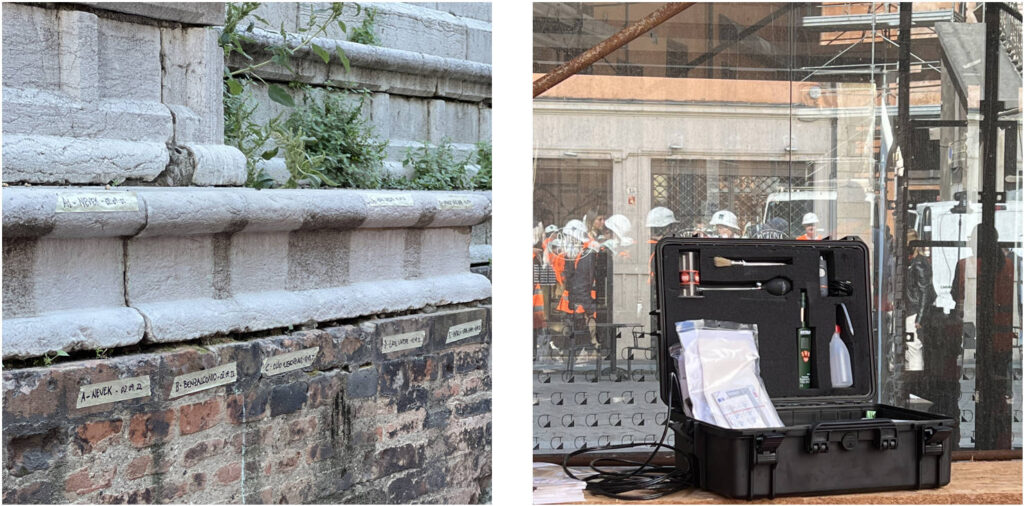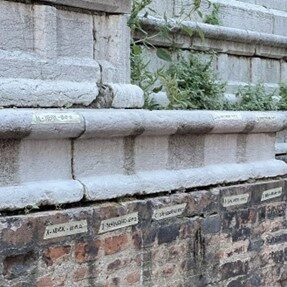A New Era of Building Scanning Documentation: Part 2

Historic preservation is an endeavor that requires immense patience, precision, and attention to detail. It involves maintaining and preserving architectural heritage, and artifacts of historical significance. 3D laser scanning technology is revolutionizing the way we approach the protection and restoration of our valuable historic artifacts and structures due to its ability to capture detailed and accurate three-dimensional digital replicas. This article delves into some specific applications of 3D laser scanning in the realm of historic preservation, focusing on its use in non-destructive evaluation, building inspection, conservation-grade documentation and beyond.
1. Building Inspection and Structural Assessment
Building inspection and structural assessment are critical components of historic preservation efforts. These activities help ensure the safety, stability, and long-term viability of historic structures. With its ability to capture a precise digital replica of the structure, 3D laser scanning and photogrammetry can provide inspectors with valuable information without the need for physical intrusion. Applications include:
1. Building Facade Inspection:
- 3D laser scanning in combination with photogrammetry can provide high definition, close-up views of the building facade, helping preservationists identify areas of decay, weathering, or damage that may require restoration.
- Preservationists can use 3D laser scan data to identify and assess structural issues, such as cracks, deformations, and deterioration in building materials for general pre-inspection, followed by detailed (close-up) inspection.
2. Vulnerability Assessment:
- Identification of structural vulnerabilities to natural disasters, such as earthquakes or flooding, allowing for the development of mitigation strategies.
3. Maintenance and Monitoring:
- Monitoring structural changes over time, helping preservationists detect deterioration or damage early and plan maintenance accordingly or as mandated by local authorities.
4. Detailed Documentation:
- Precise digital capture enables the replication of a historic buildings’ as-built or existing conditions, capturing every architectural detail and structural element.
- This documentation serves as a valuable baseline for preservation and conservation efforts.

2. HABS and HAER Documentation
The Historic American Buildings Survey (HABS) and the Historic American Engineering Record (HAER) are two prominent documentation programs in the United States that contribute significantly to historic preservation efforts. These programs focus on systematically documenting and recording historic buildings, structures, and engineering works for mitigation documentation. These records serve as valuable references for architects, engineers, historians, and preservationists when restoring, rehabilitating, or maintaining historic structures. HABS and HAER documentation also contributes to public education and awareness of the nation’s architectural and engineering heritage and are integral components of historic preservation efforts in the United States, ensuring that the architectural and engineering heritage of the country is documented, preserved, and made accessible for future generations.

3. Non-Destructive Evaluation (NDE)
Non-destructive evaluation techniques are essential tools in historic preservation, as they allow for the assessment of the condition of historic structures and artifacts without causing harm or damage. Key applications include:
1. Material Assessment:
- Ultrasonic Testing: Ultrasonic waves are used to measure the thickness of materials, detect voids, and assess the integrity of structural elements in historic buildings.
- Radiography: X-ray or gamma-ray imaging can reveal hidden structures, defects, or alterations in materials like masonry or wood.
2. Moisture and Corrosion Detection:
- Infrared Thermography: Infrared cameras can identify moisture intrusion, insulation issues, and thermal anomalies within building envelopes, helping to prevent moisture-related decay and corrosion.
- Electrochemical Techniques: Techniques like corrosion potential measurements can assess the corrosion risk of metal components in historic structures.
3. Paint and Coating Analysis:
- X-ray Fluorescence (XRF): XRF is used to determine the elemental composition of paint layers, which can help identify original colors and historic finishes.
- Infrared Reflectography: This technique can reveal underlying sketches or changes in paintings without physically removing layers of paint.
4. Structural Integrity Assessment:
- Ground Penetrating Radar (GPR): GPR can assess the condition of foundations and subsurface structures without excavation.
- Acoustic Emission Testing: This technique monitors structures for signs of stress, cracking, or damage by detecting the release of acoustic energy.
5. Wood and Timber Inspection:
- X-ray Imaging: X-rays can reveal internal wood decay, insect damage, or the presence of hidden fasteners in historic timber structures.
- Sonic and Resistance Drilling: These techniques help assess the density and strength of wood without causing visible damage.
6. Masonry and Stone Analysis:
- Ultrasound Pulse Velocity: This method measures the speed of sound through masonry or stone, helping to identify voids, cracks, or areas of deterioration.
- Digital Image Correlation: It is used to track the deformation and stress in stone or masonry elements under load.
7. Non-Invasive Archaeological Surveys:
- Ground-Penetrating Radar (GPR): GPR is employed to locate buried archaeological features, graves, or artifacts without excavation, minimizing disturbance to historical sites.
8. Monitoring and Documentation:
- 3D Laser Scanning: As previously mentioned, 3D laser scanning is non-destructive and provides detailed 3D documentation of historic structures and artifacts.
- Thermographic Monitoring: Infrared thermography can be used for continuous monitoring of temperature variations, which may indicate structural issues or moisture intrusion.
9. Statistical Analysis and Data Management:
- Advanced data analysis techniques can help historic preservationists and conservators make informed decisions based on NDE data, optimizing resource allocation for preservation efforts.
10. Conservation and Maintenance Planning:
- NDE data can inform the development of long-term preservation plans by identifying areas of concern and providing data for prioritizing conservation effort.
4. Damage and Decay Monitoring
Damage and decay monitoring tracks the progress of damage and decay over time is an essential task in historic preservation. In many cases, these destructive processes occur gradually and can be challenging to detect until significant destruction has occurred. With 3D scanning technology, however, it’s possible to capture and compare detailed scans over time, making subtle changes and deterioration immediately apparent. Moreover, these 3D scans can serve as a reference for restoration efforts, providing comprehensive and precise information about the state of an object or structure before any further decay occurs. This technology enables conservators to spot potential problems early on and take preventative measures, potentially saving invaluable historic artifacts from irreversible damage.
5. Historic Asset Cataloging
Historic asset cataloging is one of the most time-consuming aspects of historic preservation is the cataloging of historical assets. Detailed records of each object or structure must be kept, including photographs, measurements, descriptions, and any known history. 3D laser scanning can streamline this process by generating a comprehensive digital model that can serve as a complete record. In addition to holding all the physical attributes of the object or structure, the digital model can be easily stored, accessed, and shared, making it an incredibly efficient tool for record keeping. 3D laser scanning thus presents a modern solution to the age-old challenge of historic asset cataloging, promising to save time and resources while improving the quality of the records.
6. Restoration and Reconstruction of Artifacts
When the original artifacts are too fragile for public display or have suffered extensive damage over time, 3D laser scanning allows the creation of detailed 3D models which can then be used to fabricate precise replicas using materials that are better suited for handling and display. Reconstruction is another key area where 3D laser scanning plays an important role. In cases where an artifact or a portion of a historic structure has been destroyed, 3D scans of similar artifacts or the intact sections of the structure can aid in recreating a faithful reproduction. This greatly supports the preservation and the continued public appreciation of our cultural and historical heritage.
7. Public Engagement and Education
Applying 3D laser scanning technology not only helps in preservation of historic artifacts and structures but also provides a platform for wider public engagement. The 3D models created using this technology can be virtually inspected, manipulated, and explored, enabling larger audiences to interact with them. This is particularly beneficial for educational purposes, where students can examine the 3D models in a way that would not be possible with the actual artifacts. 3D models of historical artifacts can be shared online through virtual exhibitions, allowing people from all over the world to view and appreciate them. These virtual exhibitions can be equipped with interactive features for an immersive experience, helping to deepen the public’s understanding and appreciation of our shared cultural heritage.
Historic preservation is a crucial task that ensures the legacy of our past lives on for future generations. The development of 3D laser scanning technology has revolutionized this field, offering a multitude of applications that provide more accurate, efficient, and non-destructive methods for preserving our historic treasures. From non-destructive evaluation to damage and decay monitoring, structural condition assessment and tracking, to historic asset cataloging and building inspection, 3D scanning has indeed made a remarkable impact.
Moreover, it has also improved the HABS/HAER mitigation documentation process, making it more efficient and less intrusive. As technology continues to evolve, it’s likely that 3D laser scanning technology will offer even more applications in historic preservation, further enhancing our ability to protect and appreciate our historical heritage.
If you’re interested in seeing how 3D scanning technology can help with your historical preservation project, please fill out a contact form or email us at: info@3dvdt.com. Our team of experts are eager to assist and answer any questions you might have.



